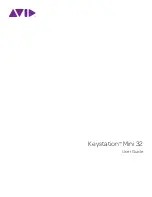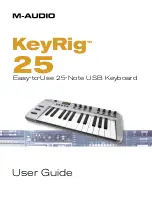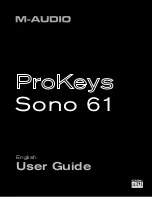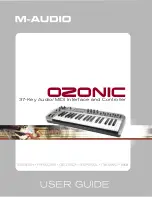
KARMA GE guide
960
Appendices
Using Auto-Bend
Auto-Bend
refers to a feature of KARMA that can
generate a bend along with every generated note. It
can be used to create gliding effects between notes
(simulating portamento), to automatically bend each
note to a preset step size, to produce guitar “hammer-
on” effects (where a fret is pressed with a finger to a
new note after the note has already been picked,
without restriking the note), ethnic bending, and other
unique effects.
Note:
There are several other ways of producing Pitch
Bend data in KARMA, including using Pitch Bend
Envelopes, and generating stepped Pitch Bend with
the CCs/Pitch Group. This chapter does not apply to
those additional methods.
Next Note/Previous Note Bends
Generated
When the “GE Type”(
0: Generated-Riff
or
1: Generated-Gated
, Next Note Bending allows the
current note to bend to what will be the next note, the
note two away, or the note three away. Previous Note
Bending allows the current note to bend to what was
the previous note, the note two notes previous, or the
note three notes previous.
When beginning a riff with
Previous Note bends
selected, since the first notes have not actually been
played yet, KARMA extrapolates what they would
have been based on the settings of various parameters.
Most of the time this will produce a correct bend.
When using
Next Note bend
with Random Modes,
KARMA actually does know what the next Note(s)
will be, even though they are “Random”.
If the note to be bent to is the same note as the current
note (a bend of
0
) KARMA automatically chooses a
bend to another note nearby to maintain the illusion of
continuous bending.
Note:
The maximum bend size is controlled by the
Bend Range setting (usually 12 semitones), even if the
next/previous note is farther away.
Also, although KARMA knows what the next notes
will be while it is playing a riff, it can’t know when you
are going to change a chord and start a new riff.
Therefore, the last notes before a chord change may not
bend to the correct notes at the start of a new riff, since
they will bend to what would be the next note if you
hadn’t changed chords. Most of the time this is not a
problem and still sounds musically correct.
When using Next/Prev Note Bending with Clusters,
Clusters will appear to bend from their bottom note to
whatever the next/previous note is.
Real-Time
When the “GE Type”(
3: Real-Time
, only
Previous Note bending
is available, since KARMA
cannot know which note you will play next. However,
by using the Bend Direction parameter, you can bend
either “To” the previous note, or “From” the previous
note to the one you are playing now. The Bend Shape
you are using probably determines which one makes
more sense. For example, for Hammer-ons you will
probably want to bend “To” the previous note (because
the Hammer Shape bends it back afterwards); while
for the Bend Shape, you will probably want to bend
“From” the previous note to the one you have played
now, since that is where the bend will end up to the ear.
However, it’s up to you!
Length Of Bends
“GE Type” 0: Generated-Riff,
1: Generated-Gated or 2: Generated-Drum
Bend Group “Length” is 0…23: Note Values
The bend length is determined by the chosen note
value and will be the same regardless of the actual
duration or rhythm of the notes. For example, if the
Bend Group “Length” is
7: 16th
, then the overall Bend
will be within a 16th note, even if you are generating a
pattern with quarter notes, eighth notes, and 16th
notes mixed together. This allows each bend to be the
same length, yet maintain a relationship to tempo,
since slowing down the tempo will also lengthen the
bend, for example. This also allows the durations of
the notes to be varied in real-time without changing
the position or length of the bends.
Bend Group “Length” is 24: Fixed-ms
The overall bend is determined by a fixed value in
milliseconds, and will be the same length regardless of
the tempo setting. For example, this allows an absolute
bend length to be determined that does not change
with the tempo, so that a guitar line with a bend in it
will play slower at a slower tempo, but not bend any
slower. This also allows the durations of the notes to be
varied in real-time without changing the position or
length of the bends.
Bend Group “Length” is 25: Note Duration
The length of the bend is a percentage of the note’s
duration. Therefore, if you have the Duration Group
parameters set to produce very short durations, then
very short bends (almost inaudible) will be produced.
However, with normal length durations, using this
mode allows the bend to be scaled with each note -
longer notes get longer bends, shorter notes get shorter
bends, etc. Changing the durations of the notes in real-
time changes the length and position of the bends.
Note that a bend will never be longer than the rhythm
of the generated note itself, even if you are creating
overlapping notes. In other words, the start of a new
note stops the current bend, and potentially starts
another one. The diagram in the next section illustrates
the resulting bend when the shape is “Bend,” and
shows the difference between using Note Duration and
one of the other “Bend Length” settings.
Summary of Contents for Electronic Keyboard
Page 1: ...Parameter Guide Parameter Guide ...
Page 2: ......
Page 180: ...Program mode EXi 170 ...
Page 290: ...EXi STR 1 Plucked String 280 ...
Page 572: ...Sequencer mode 562 ...
Page 700: ...Global mode 690 ...
Page 751: ...Insert Effects IFX1 IFX12 Routing 741 Fig 2 3a Fig 2 3b ...
Page 902: ...Effect Guide 892 ...
















































